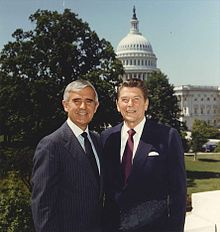Paul Laxalt
He was the son of Basque parents, Therese (née Alpetche)[1] and Dominique Laxalt, who emigrated to the United States in the early 1900s from their homeland in the French Pyrenees.
Therese, who had been trained at Paris's Le Cordon Bleu cooking school, eventually opened a restaurant called The French Hotel in Carson City, Nevada.
Robert became an author; Suzanne, a Roman Catholic nun; John, a lawyer and political consultant; Marie, a school teacher; and Peter (Mick), an attorney.
[citation needed] The Laxalt children were raised largely by their mother, as Dominique spent long periods of time away from the household tending his sheep in the deserts and mountains of Nevada.
[citation needed] Paul played on the 1938 state basketball champion team at Carson High School[3] before graduating and attending Santa Clara University.
When World War II broke out, Paul joined the U.S. Army and served as a medic, seeing action in the Battle of Leyte in the Philippines.
[5] Paul Laxalt's first attempt for public office was in 1950 when he ran for District Attorney of Ormsby County, Nevada, turning out the incumbent D.A.
A great amount of pressure was applied to Laxalt to run in Bell's place, but the young attorney demurred, and he remained in the lieutenant governor's race.
[6] In 1964, while serving as lieutenant governor, Laxalt ran for the United States Senate against freshman Democratic incumbent Sen. Howard Cannon.
The next morning he flew to Las Vegas where he was told that certain precincts reported late and that Cannon had won by 48 votes, among the narrowest margins in a popular election for the U.S. Senate.
The Federal Bureau of Investigation (FBI) and Justice Department had deep suspicions about organized crime's involvement in the gambling industry.
(In fact, one of Laxalt's first moves after his election was to meet with FBI Director J. Edgar Hoover to express Nevada's desire to establish a cooperative relationship.)
During the gubernatorial campaign, Laxalt also led a movement to purge members of the John Birch Society from the state Republican Party.
[7] Laxalt governed Nevada as a fiscal conservative, but felt compelled to raise taxes at the outset of his administration because of the budget situation.
Indeed, throughout his Senate tenure, Laxalt remained popular among his colleagues, principally because he was viewed as a "straight shooter" and someone who never allowed political differences to turn personal.
Negotiating principally with Sen. Ted Kennedy and Sen. Joe Biden from Delaware, Laxalt was able to strike a deal that allowed the committee to vote on the nomination.
During the 1980 Republican National Convention, Laxalt's name was floated as a potential vice presidential nominee for the Reagan ticket, but George H. W. Bush was chosen instead.
In fact, during Laxalt's second Senate term, several Nevadans came to Washington, D.C., due in large measure to his relationship with Reagan, to serve in prominent governmental and campaign positions.
In early 1987, Laxalt was at the top of the short list to replace Donald Regan as White House Chief of Staff, but he declined because he intended to run for president in 1988.
Ford enjoyed widespread support among the Republican establishment, particularly in Washington, D.C. Reagan decided that having Laxalt serve as his national chairman would give his campaign credibility it was otherwise lacking.
[citation needed] With his back to the wall, Reagan won shocking victories in North Carolina and Texas, which propelled the race all the way to the national convention in Kansas City.
One of the panelists, former U.S. Attorney General Griffin Bell, who had served under President Jimmy Carter, said that he would have preferred awarding $2 million, but he felt the final amount was "fair."
After his retirement from the U.S. Senate, Laxalt was named by President George H. W. Bush to a prestigious deficit reduction panel that consisted of current and former members of Congress and other prominent Americans.
The Paul Laxalt Mineral Engineering Center, an $11 million building that was completed in 1983, has been described as a giant step forward for the University of Nevada-Reno and the School of Mines.
[citation needed] One of Laxalt's initiatives that gave him great personal satisfaction was the "Intern" program he established during his two terms in the United States Senate.
The program was designed to bring college-age students to Washington, D.C., to work in Laxalt's Senate office for the equivalent of a college semester.
[22] In the 2022 midterm elections, Adam narrowly lost his bid to unseat Catherine Cortez Masto, the incumbent United States Senator from Nevada.
"[27] On September 6, 2018, a funeral service was held for Senator Laxalt at St. Matthew's Cathedral in Washington, D.C. Attendees included former Vice President Dick Cheney, former Senate Majority Leader Bob Dole, former Attorney General Edwin Meese III and scores of Nevadans who made the trek to the nation's capital to pay their last respects to Laxalt.
In addition, several former Laxalt staff members attended including Doug Fuller, Robbie Aiken, Hal Furman and Gene Drakulich.
A few weeks later, with family and close friends present, and in honor of his service during World War II, Laxalt was interred at Arlington National Cemetery.




